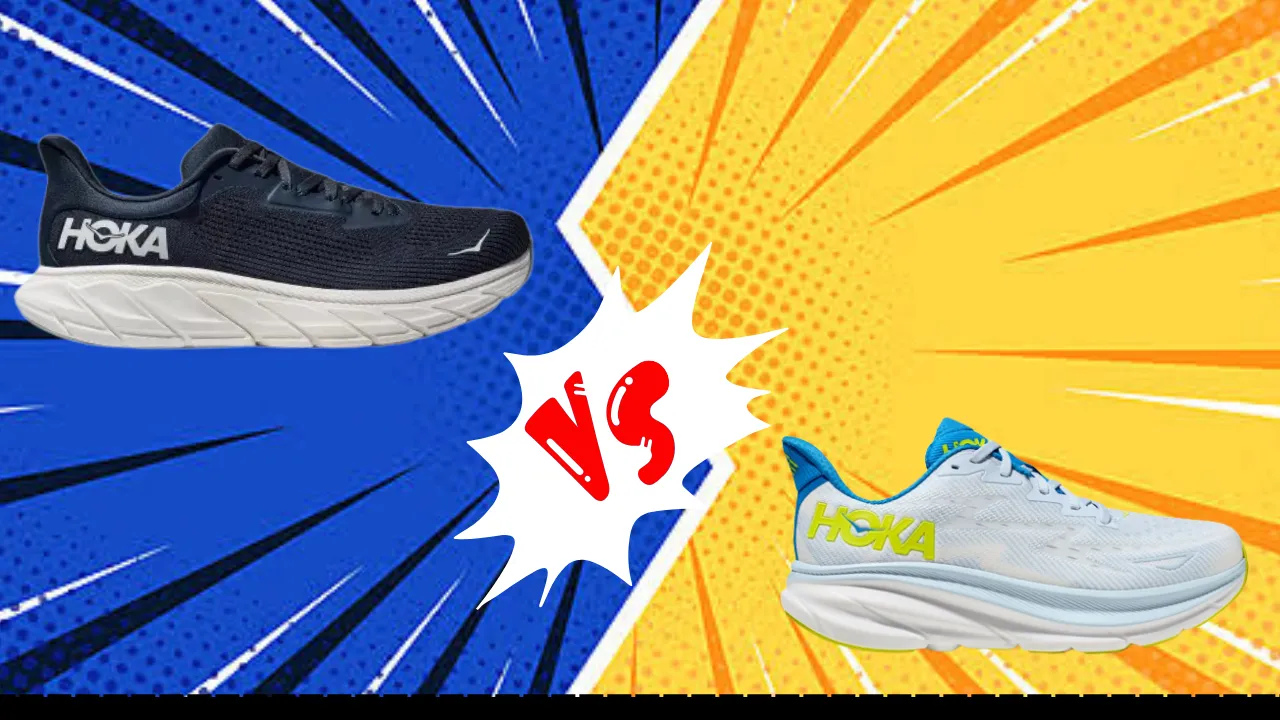The Hoka Arahi 7 and Clifton 9 are both premium neutral daily trainers from Hoka One One’s road running lineup. But with two different cushioning philosophies, which Hoka is best for your needs?
We break down the key differences in an in-depth Clifton vs Arahi comparison review. Let’s begin.
Similarities And Differences Between Hoka Clifton 9 And Arahi 7:
| Features | Hoka Arahi 7 | Hoka Clifton 9 |
|---|---|---|
| Launched In | 2024 | 2023 |
| Stability | J-Frame technology for stability | Neutral |
| Flexibility | Some flexibility | Flexible |
| Sizing | Standard | Runs small/narrow |
| Weight | 8.1 oz (W), 9.9 oz (M) | 8.7 oz (M) |
| Cushioning | Firm | Highly cushioned, soft |
| Outsole | Rubber | Rubber |
| Midsole | Compression molded EVA with J-Frame | CMEVA foam |
| Upper | Engineered mesh | Engineered mesh |
| Retail Price | $145 | $145 |
Features Comparison
Materials
The Arahi 7 utilizes compression molded EVA foam in the midsole which provides responsive cushioning and support. This firmer foam is durable and provides a stable platform. Hoka’s J-Frame technology in the midsole integrates two different densities of foam to guide overpronation.
On the outsole, high-abrasion rubber is strategically placed for durability in key high-wear areas. The upper uses an open-engineered mesh material that balances breathability and structure.


In contrast, the Clifton 9 features softer CMEVA foam in the midsole. This proprietary midsole foam combines soft cushioning for impact absorption with responsiveness for energy return. The result is a plush but lively ride.
The outsole uses full ground contact high-abrasion rubber for traction and durability on the road. The upper incorporates an engineered mesh that is highly breathable while also providing a comfortable fit. Unlike the Arahi 7, the Clifton 9 does not use stability elements in its straightforward construction.
Durability
The firmer compression molded EVA foam midsole and strategically placed rubber outsole of the Arahi 7 provide excellent durability that can handle heavy mileage training cycles.
The J-Frame technology helps maintain structured stability and pronation control even after significant wear. The engineered mesh upper is also designed for resilient breathability mile after mile. Runners have reported the Arahi 7 lasting over 500 miles before signs of midsole breakdown.
The Clifton 9’s soft CMEVA foam provides a very comfortable ride, but this softer foam may lose some bounce and responsiveness sooner than the Arahi 7. Heavier runners in particular have noticed the Clifton 9’s cushioning compresses over 300-400 miles.
However, the full ground contact rubber outsole maintains traction and protection as the mileage piles up. The engineered mesh upper is also durable and retains structure even after being soaked with sweat on long runs. But overall, the Arahi 7 is built with more durability in mind than the Clifton 9.
Fit
The Arahi 7 has a medium volume fit through the midfoot and forefoot suitable for most foot shapes. The engineered mesh upper breathes well and has comfortable cushioning around the ankle collar. The toe box room is on the lower end of average, so some may find it too snug.


Going up half a size can allow more wiggle room if needed. The Arahi 7 runs true to size length-wise for most, but wide footers may struggle with the D medium widths. Trying them on first is recommended.
Unlike the accomodating Arahi 7, the Clifton 9 is known for its notoriously narrow, slim fit – especially through the midfoot and toebox. There is much less volume compared to the Arahi, resulting in a squeezed ride for wide footers.
The Clifton 9 runs at least a half size small, so sizing up is often necessary to allow enough length. However, due to the narrow build, sizing up further than half may result in heel slippage.
The snug engineered mesh upper also has less give than the Arahi’s. For the best fit, trying the Clifton 9 on in person is highly advised before purchasing. Be ready to size up at least a half or full size.
Stability
The Arahi 7 was specifically engineered as a stability shoe to provide pronation control for runners who overpronate or have fallen arches. The J-Frame technology in the dual-density midsole integrates firmer foam on the medial side to slow excessive inward rolling of the foot during the gait cycle.
Guidance lines on the outsole also help improve transitions and keep the foot stable on impact. For moderate to severe overpronators, the Arahi 7 provides the best motion control compared to neutral shoes like the Clifton 9.
In contrast, the Clifton 9 does not use any pronation correction elements in its design. The uniformly soft CMEVA foam midsole cushions do not restrict the natural movement and flexibility of the foot. This gives it a smooth, neutral ride but without the gait guidance of stability shoes.
For runners with excessive inward foot tilt, the Clifton 9 lacks the support and control offered by the structured Arahi 7. The plush cushioning caters more towards impact absorption rather than correcting overpronation.
Cushioning
The Clifton 9 focuses solely on providing the softest, pillowy ride possible using its high-thickness CMEVA foam midsole and a beveled heel. This allows better shock absorption and protection for joints, especially on recovery days and long mileage.
However, the spongy foam mute responsiveness for a somewhat lifeless, sluggish feel that is not ideal for faster paces. The Meta-Rocker midsole geometry does help smooth out the transitions. Overall, the Clifton 9 prioritizes cushion over energy return for easy miles.
While the Arahi 7 doesn’t have the same pillowy plushness as the Clifton 9, its blend of compression-molded EVA gives it a springier, responsive ride for uptempo running. Though firm, the cushioning provides adequate protection without feeling deadened or flat.
The rockered geometry also delivers smoother transitions off the heel through toe-off. For tempo runs, speedwork, and races, the firmer Arahi 7 has a more energetic, propulsive sensation compared to the marshmallowy Clifton 9.
Value
With an MSRP of $145, both the Arahi 7 and Clifton 9 sit at the pricier end of daily trainers. The significant use of lightweight, responsive midsole foams does come at a cost.
However, the Arahi 7 midsole materials, stability elements, and durable outsole help justify the price for overpronators. You get a long-lasting stability shoe with gait control that can easily log 500+ miles.
In contrast, the Clifton 9 is not very durable for its $145 price, with the soft foam wearing down after 300-400 miles. You pay more for the short-term plush cushioning.
Performance Comparison
Walking
The Clifton 9’s plush cushioning absorbs impact better during walking, while the Arahi 7’s firm ride lacks the same shock attenuation. The Arahi 7’s stability features are less important for walking.
Running
For easy runs and long distances, the Clifton 9 provides a softer feel that is more forgiving on joints. The Arahi 7 feels more responsive at faster paces like tempo runs, but the stability limits flexibility.
Plantar Fasciitis
The Clifton 9’s well-cushioned sole is better at reducing pressure on the feet, ankles and heels that can aggravate plantar fasciitis. The EVA foam also softens impact during foot strikes.
All Day Standing
The Arahi 7’s firmer midsole makes it less suitable for all-day standing comfort. The plush Clifton 9 cushioning absorbs shock better and reduces fatigue during long periods on your feet.
Final Verdict:
For runners needing pronation control, the Hoka Arahi 7 is the better stability option. But for a softer, well-cushioned ride, the Clifton 9 is the clear choice. Just be aware of the tighter fit.
With that, this exciting matchup comes to an end. Let me know your thoughts on both models in the comments down below.

